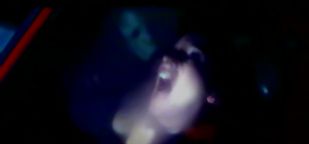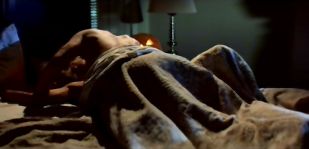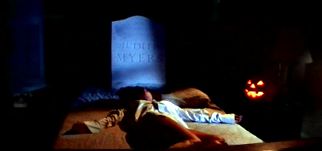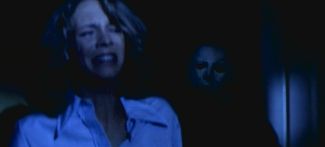PAGE 3
HALLOWEEN
is all about contrasts- both visually and thematically. It would be wrong
to review this film without some mention of the superb cinematography (by
Dean Cundey) (or, indeed, Carpenter's mesmerising score), and the way that
Carpenter expertly frames  every
shot (the reason why it works so much better in widescreen). The shape is,
literally in many scenes, a ghostly floating white jack-o'-lantern emerging
from a sea of blackness. This also includes the 'fade', which is most effective
in the scene when Jamie Lee Curtis has found her friends slain and is reeling
in horror on the landing- Myers launches at her as if he's been spat out by
the dark. … The other contrast is between the true nature of Halloween (which
Myers as the Boogeyman represents) and the cosy Disney version that Jamie
Lee and the other inhabitants of Haddonfield celebrate every year- one where
the meaning of true horror has been lost behind its familiarity. What also
makes Myers even more terrifying for the inhabitants of Haddonfield is the
fact that although the Shape represents the unknown- the thing in the dark,
he is also, in some ways, one of them (again these contradictions). He is
not some completely alien threat- he is in-fact one of their sons (at least
in body)… returning home…
every
shot (the reason why it works so much better in widescreen). The shape is,
literally in many scenes, a ghostly floating white jack-o'-lantern emerging
from a sea of blackness. This also includes the 'fade', which is most effective
in the scene when Jamie Lee Curtis has found her friends slain and is reeling
in horror on the landing- Myers launches at her as if he's been spat out by
the dark. … The other contrast is between the true nature of Halloween (which
Myers as the Boogeyman represents) and the cosy Disney version that Jamie
Lee and the other inhabitants of Haddonfield celebrate every year- one where
the meaning of true horror has been lost behind its familiarity. What also
makes Myers even more terrifying for the inhabitants of Haddonfield is the
fact that although the Shape represents the unknown- the thing in the dark,
he is also, in some ways, one of them (again these contradictions). He is
not some completely alien threat- he is in-fact one of their sons (at least
in body)… returning home…
One
of the charges made against HALLOWEEN was that Carpenter initiated
the idea of sex=death in the slasher movie. That, in some way, the promiscuous
were punished for their loose ways. It was a notion that  perversely
was popular in the politically conservative early 80's, where the backlash
against the sexual revolution got underway with the advent of rabid bigotry
and misplaced fear. Not that the movies were popular with them (horror films
are generally persecuted by both sides of the political divide), but the notion
of punishment, however, was. Despite the fact that many subsequent films involved
the sex=death equation (which if truth be told had more to do with showing
a little t&a rather than any moral leanings), Carpenter is adamant that he
was not moralising in HALLOWEEN. He said, if anything the girls were
acting normally- like teenagers do. The fact that Jamie Lee Curtis was so
virginal had more to do with showing how, in some ways, "..because she's
repressed", she had more in common with Myers than she did with her friends-
she was the abnormal one. Annie and Lynda's small town bubble is burst violently,
but quickly- Laurie Strode however is aware for much of the movie that this
Halloween is not like all the others. She is slowly, but surely, tumbling
inexorably into the same nightmare of fear
perversely
was popular in the politically conservative early 80's, where the backlash
against the sexual revolution got underway with the advent of rabid bigotry
and misplaced fear. Not that the movies were popular with them (horror films
are generally persecuted by both sides of the political divide), but the notion
of punishment, however, was. Despite the fact that many subsequent films involved
the sex=death equation (which if truth be told had more to do with showing
a little t&a rather than any moral leanings), Carpenter is adamant that he
was not moralising in HALLOWEEN. He said, if anything the girls were
acting normally- like teenagers do. The fact that Jamie Lee Curtis was so
virginal had more to do with showing how, in some ways, "..because she's
repressed", she had more in common with Myers than she did with her friends-
she was the abnormal one. Annie and Lynda's small town bubble is burst violently,
but quickly- Laurie Strode however is aware for much of the movie that this
Halloween is not like all the others. She is slowly, but surely, tumbling
inexorably into the same nightmare of fear  that
has haunted Dr. Loomis (Donald Pleasance) for years…
that
has haunted Dr. Loomis (Donald Pleasance) for years…
The
stark comparison between Myers as some kind of embodiment of arcane evil and
the supposed safety of suburbia is intensified by the almost medieval fervour
with which Dr. Loomis pursues his former charge. It is tempting to almost
view him as the typical loony in-so-much as it is he who raves and
spits; it is he that is demonstratively obsessed. Characteristics that we
would have normally associated with insanity. Indeed Loomis is undoubtedly
unbalanced- something that probably doesn't do him any favours; judging by
the sideways glances the bemused Sheriff gives him as he vents his paranoid
suggestion that "Death has come to your little town". Less rabid outbursts
may have convinced Haddonfield of the impending slaughter, but that's purely
hypothetical… What is clear though is that Loomis believes that Myers is more
than merely an escaped lunatic- his refusal to refer to him as human, rather
as an  "evil",
shows that he, a man of medicine- specifically of psychiatry, a profession
which routinely debunks superstition and belief in possession- has come to
believe that Myers embodies a horror beyond the constraints of natural insanity.
In fact Loomis, for all intents and purposes, takes on the role of witch-hunter
(complete with all the connotations of devils and demonology)- he has no doubts
that what he is hunting is no longer human; that Myers is some kind of devil
("[with] the blackest eyes"). When, at the end of the movie, Loomis
had shot Myers, filling him with enough lead to kill any normal man and sending
him over the balcony into the garden below, Pleasance had asked Carpenter
which way he should play it when he looked down and saw that Myers had gone.
Carpenter said he could play it either that he was surprised; or as if he
knew that that would happen- he would know instinctively which was right.
He, of course, chose the latter- as Tommy Jarvis told Laurie Strode, "You
can't kill the boogey man!"- something that Loomis had suspected that
all along…
"evil",
shows that he, a man of medicine- specifically of psychiatry, a profession
which routinely debunks superstition and belief in possession- has come to
believe that Myers embodies a horror beyond the constraints of natural insanity.
In fact Loomis, for all intents and purposes, takes on the role of witch-hunter
(complete with all the connotations of devils and demonology)- he has no doubts
that what he is hunting is no longer human; that Myers is some kind of devil
("[with] the blackest eyes"). When, at the end of the movie, Loomis
had shot Myers, filling him with enough lead to kill any normal man and sending
him over the balcony into the garden below, Pleasance had asked Carpenter
which way he should play it when he looked down and saw that Myers had gone.
Carpenter said he could play it either that he was surprised; or as if he
knew that that would happen- he would know instinctively which was right.
He, of course, chose the latter- as Tommy Jarvis told Laurie Strode, "You
can't kill the boogey man!"- something that Loomis had suspected that
all along…

